
Johann Sebastian Bach
(1685-1750)

Contents

Delphi Classics 2018
Version 1

Delphi Great Composers
Johann Sebastian Bach

By Delphi Classics, 2018
COPYRIGHT
Delphi Great Composers - Johann Sebastian Bach
First published in the United Kingdom in 2018 by Delphi Classics.
Delphi Classics, 2018.
All rights reserved. No part of this publication may be reproduced, stored in a retrieval system, or transmitted, in any form or by any means, without the prior permission in writing of the publisher, nor be otherwise circulated in any form other than that in which it is published.
ISBN: 978 1 78656 122 0
Delphi Classics
is an imprint of
Delphi Publishing Ltd
Hastings, East Sussex
United Kingdom
Contact: sales@delphiclassics.com

www.delphiclassics.com
The Masterworks

Eisenach, a town in Thuringia, Germany, thirty miles west of Erfurt Bachs birthplace

Eisenach in 1647
The Masterworks: A Short Guide

In this section of the eBook there are concise introductions for Johann Sebastian Bachs most celebrated works. Interactive links to popular streaming services are provided at the beginning and end of each introduction, allowing you to listen to the music you are reading about. The text is also accompanied with contextual images to supplement your reading and listening.
There are various options for streaming music, with most paid services charged competitively at the same rate and usually offering a similar range of albums. Various streaming services offer a free trial ( Google Play Music , Amazon Music Unlimited and Apple Music ) and Spotify offers a free service after you watch a short advertisement. Amazon Prime members can also enjoy a wide range of free content from Amazon Prime Music . If you do not wish to subscribe to a streaming service, we have included YouTube links for free videos of the classical pieces.
Please note: different eReading devices serve hyperlinks in different ways, which means we cannot always link you directly to your chosen service. However, the links are intended to take you to the best option available for the piece of music you are reading about.
High-resolution scores for the music would be too large in size to include in an eBook; however, we have provided links to free scores available at IMSLP , the International Music Score Library Project, which can be accessed from the SCORES links in each chapter.
Now, settle back and relax as you immerse yourself in the music and life of Bach...
Toccata and Fugue in D Minor, BWV 565

AMAZON APPLE GOOGLE SPOTIFY YOUTUBE SCORES

In 1685 Johann Sebastian Bach, the paramount German composer of the Baroque period, was born into a great musical family in Eisenach, Saxe-Eisenach. His father, Johann Ambrosius Bach, was the director of the town musicians and his uncles were also professional musicians. His mother was Maria Elisabeth Lemmerhirt, the daughter of Valentin Lemmerhirt, a furrier and coachman from Erfurt. It is likely that Bachs father taught him to play the violin and harpsichord, while his brother Johann introduced him to contemporary music.
Tragedy was to strike early for the young Bach, when his mother died in 1694 he was aged only nine and his father died eight months later. Bach moved in with his eldest brother, Johann Christoph Bach, the organist at St. Michaels Church in Ohrdruf, Saxe-Gotha-Altenburg. There he studied, performed and copied music, while his brother also instructed him on the clavichord. He explored the works of the great composers of the day, including South German composers such as Johann Pachelbel and Johann Jakob Froberger.
In April 1700, Bach was enrolled at the prestigious St. Michaels School in Lneburg, some two weeks travel north of Ohrdruf. His two years there were critical in familiarising the composer with a wider range of European culture. In addition to singing in the choir, he excelled at playing the Schools three-manual organ and harpsichords. Mingling with the sons of aristocrats from northern Germany, he was to form several important relationships for his later career.
Shortly after graduating from St. Michaels in 1703, Bach was appointed court musician in the chapel of Duke Johann Ernst III in Weimar. During his seven-month tenure at Weimar, his fame as a keyboardist soon spread and he was invited to inspect the new organ and give the inaugural recital at the New Church in Arnstadt. This subsequently won him the position of organist at the church, with light duties, a relatively generous salary and access to a fine new organ, allowing the performance of a wider range of keys.
Ultimately, Bach was dissatisfied with the standard of singers in the choir and in 1706 he applied for a post as organist at the Blasius Church in Mhlhausen. A month later his application was accepted and he took up the position in July. It included a significantly higher remuneration, improved conditions and a more accomplished choir.
It is believed that during this formative period, Bach composed his Toccata and Fugue in D Minor, BWV 565 , one of his most memorable pieces of his entire oeuvre. A two part musical composition for organ, it is renowned for its majestic sound, dramatic authority and driving rhythm. It had become famous for modern listeners due to its inclusion in the 1940 Disney classic Fantasia , in which it was adapted for orchestra by the conductor Leopold Stokowski. The piece also shares a strong association in Western culture with horror films and funeral-themed scenes in various media.
The first part is a toccata (from the Italian toccare, to touch), representing a musical form for keyboard instruments, intended to exhibit the organ players virtuosity. Toccatas often served as introductions and foils for fugues, setting the stage for the complex and intricate composition to follow. As found in many toccatas, the piece demonstrates many fast arpeggios (chords played in a series rather than simultaneously) and runs up and down the keyboard, though it is generally composed in free form, allowing the composer much freedom for personal expression.
Next page





















